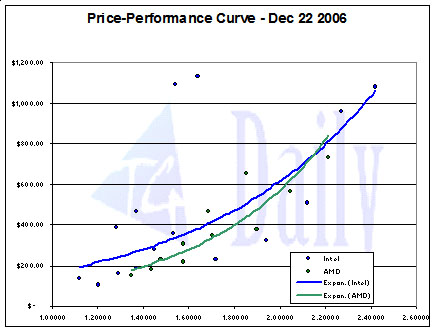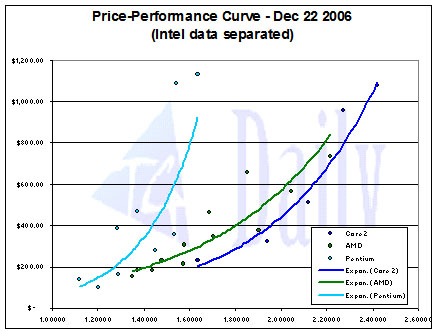Price/Performance Analysis: AMD increases pressure on Intel
FX quad improves AMD's price/performance curve
For the first time since our first installment of the weekly charts in October, we can see a huge graphical change, thanks exclusively to the new FX processors added to the list. That may come as a surprise to some, as the performance of the dual-core processors, sold only in pairs, was rather disappointing in Tom's Hardware's first benchmark. But combine the added performance with a very low price and you have a winner. In fact, the impact is large enough to drop most of its price curve below Intel's combined (900 series and Core 2 Duo series) curve.
Click to enlarge
Clearly, though, it is not a huge leap. The distance between the two trendlines is quite slim. A main reason for AMD's lower curve is the large amount of price decreases over the past few weeks. So how did the new processors affect AMD's price/performance correlation? It caused it to fall a bit from last week, down 1.8% from 0.925 to 0.908, which is still obviously a very high correlation, and of course the fact that it caused the trendline to dip is more important to the consumer than a minimal decrease in its correlation value.
Intel's correlation also fell, to a new record low for our weekly charts. It fell to 0.607, down 4.9% from last week's 0.638. Since November 10, we've logged six weeks with correlation decreases and only one week when it went up. Unlike AMD, when we usually see price shifts similar across the board, there's just been no big trend for Intel. Prices just seem to jump around.
Click to enlarge
When we cut the Intel data into separate trendlines for the low-end and high-end groups, we really get to see what is happening between AMD and Intel as a result of the new FX processors. Unlike previous weeks, where this image saw AMD sandwiched virtually perfectly in the middle of the two Intel lines, it is curving drastically to the right with the addition of the FX-70 series. However, the Core 2 products from Intel still outpace AMD on an average performance-per-dollar scale.
Of course, our charts do not recognize the major downside of AMD processors. Keep in mind that the added performance of an FX package comes at twice the power consumption (or about 250 watts) of the single dual-core FX processors.
Get Tom's Hardware's best news and in-depth reviews, straight to your inbox.
Correlation-wise, it's interesting to see that Intel's separated trendlines have similar values to what we saw last week. The Pentium line saw a correlation of 0.777 this week, actually up to last week's 0.754. The Core 2 processors ranked in at 0.915, exactly the same as last week. So the prices within these groups changed such that they didn't negatively impact the intra-group correlation, but caused a downward swing when we look at all the processors together.
AMD's processors do not pose a real material threat to Intel's QX6700 and EX6800 processors, especially with the overclocking potential with the former. However, it does at least put AMD on the high-end map. We will have to see if this downward price swing continues for AMD, or if they will rebound back up after the novelty of the new processors wears off.
Current page: FX quad improves AMD's price/performance curve
Prev Page Prices as of Dec. 22: AMD's sort-of-quad-core for $380
Mark Raby is a freelance writer for Tom's Hardware, covering a wide range of topics, from video game reviews to detailed analyses of computer processors.

